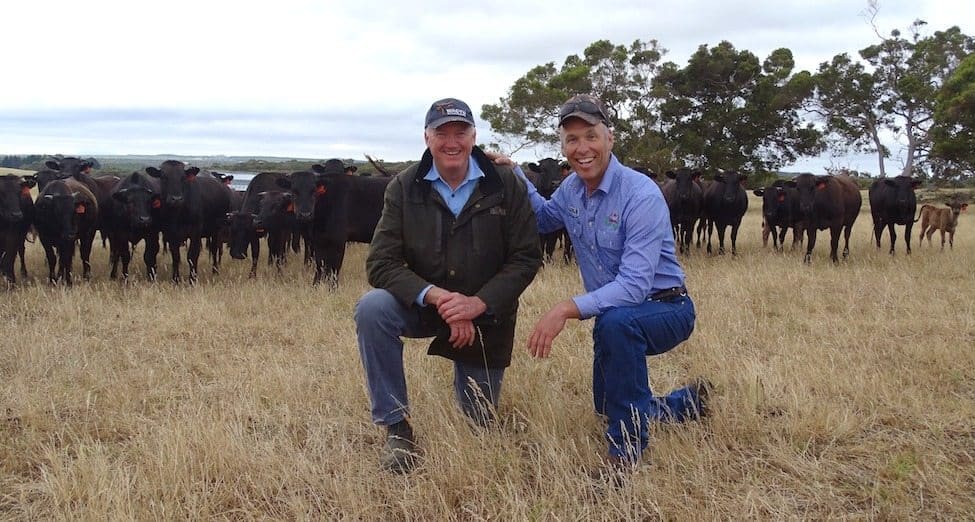
Enoch Bergman, right, and Peter Gilmour.
Among Australia’s early adopters of the Wagyu breed, the Gilmour family has used AI, embryo transfer and pasture improvement to double carrying capacity, build their herd and accelerate genetic advancement in their West Australian enterprise.
Bill Gilmour originally established the Great Southern region property in 1967, today run by four of his offspring — Peter, Michael, Jenny and Jacqui.
It was former Japanese-based America’s Cup coach and skipper Peter who first suggested they look at Wagyus, as a result of his experiences having lived with his family in Japan including tasting the exquisite beef product.
The Gilmours run 1200 breeders — 700 full-blood Wagyu and 500 Angus, with a mix of commercial and stud production. Their markets are varied, including feeder cattle, a local premium boxed-beef product and selling stud sires.
“We’re really in a growth phase, trying to grow our Wagyu herd numbers to around 2000 breeders,” Peter explained.
“As we grow our Wagyu full-blood numbers, we’re decreasing our Angus herd; however, we still use them for first-cross Wagyu-Angus production.
“An important part of the process has been harvesting embryos from our elite Wagyu full-bloods and implanting them into Wagyu/Angus recipients.
“Our tough selection pressure needs a solid embryo transfer program to grow numbers effectively.”
Peter says 30 years ago, they used vets “for reactive challenges” only, but in the last six years have had a more proactive approach, using Dr Enoch Bergman of Swans Veterinary Services at Esperance, WA, to help with better overall herd management and critical production advice.
Dr Bergman is an accredited Australian Cattle Veterinarians (ACV) member and a past president of the ACV.
Peter, president and board chairman of the Australian Wagyu Association, initially met Enoch at a presentation he gave on Bovine Viral Diarrhoea Virus (BVDV).
“It heightened the importance of being ‘premium’ across everything if you’re going to be a seedstock producer,” Peter said.
“We have improved our induction protocols and now know how to deal with PI’s and to systematically manage BVDV.
“Our philosophy is that we’re happy to develop and spend money that will create long-term returns and substantial value.
“I think Australian Cattle Vets, and having a deep engagement with one of their members, is one of the absolute fundamentals that goes with that.”
“For example, sure, we could run an AI program ourselves, but actually realising the difference between say, 60pc and 70pc in AI conception rates is hugely important to us.
“The knock-on effect down through the years is really quite profound; for example, you might save a little money in the short term, but your loss is just massive as you compound that out.”
Enoch guides Irongate’s AI program, including insemination, and then returns five to six weeks after the back-up bulls are removed to age foetuses, discerning those sired by AI, and to identify empties via ACV’s pregnancy scanning program PregCheck.
“Parent verification will tell this, but doing it early allows Irongate to plan ahead. This is a tremendous advantage,” Peter said.
“We’ve been able to look at semen performance, and track the fertility and take-rates of all of our individual AI program sires.
“We have identified some sires with take-rates as high as 89pc through AI, and some as low as 35-40pc.
“Utilising Enoch for pregnancy testing closes the loop, allowing us to optimize our forward planning regarding sire selection. Just one percentage move in take-rates is a huge economic outcome down the road.”
Along with PregCheck, the ACV’s bull-fertility testing program BullCheck has potential to provide further value to Irongate’s production equation.
“As demand for our bulls grows, we are keen to integrate a best practice approach to ensuring our bulls will meet the demands of our clients,” says Peter.
Enoch says the training to become an accredited cattle vet is rigorous, but is worthwhile.
“My role as a cattle vet is to improve my clients’ profitability without sacrificing welfare outcomes.
“That’s where the PregCheck scheme is so good. We’re accountable, we’re auditable and we add value to producers via proven accuracy. The return from preg checking is over one thousand percent.
“Empty cows can exit the production system a lot earlier than waiting to see if they calve.
“Every two empty animals found means room in the system for one more breeder, which equals an additional $1,000 calf in today’s market, that’s an excellent return.
“That return on investment is absolutely underpinned by accuracy.
“But whilst we are there, crush side, ACV vets can also add a lot of value to producers that are less tangible.”
Peter agrees, “There are so many different values beyond the obvious task that you’re asking the cattle vet to do.”
Source: ACV



HAVE YOUR SAY